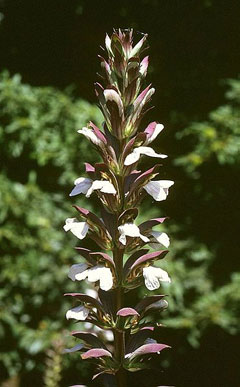 |
|
http://commons.wikimedia.org/wiki/User:Liné1 |
 |
| http://commons.wikimedia.org/wiki/User:Franz_Xaver |
Translate this page:
Summary
Physical Characteristics

 Acanthus mollis is a PERENNIAL growing to 1.2 m (4ft) by 0.6 m (2ft in). It is in flower from June to August. The species is hermaphrodite (has both male and female organs) and is pollinated by Bees.
Acanthus mollis is a PERENNIAL growing to 1.2 m (4ft) by 0.6 m (2ft in). It is in flower from June to August. The species is hermaphrodite (has both male and female organs) and is pollinated by Bees.
Suitable for: light (sandy) and medium (loamy) soils and can grow in heavy clay soil. Suitable pH: mildly acid, neutral and basic (mildly alkaline) soils. It can grow in semi-shade (light woodland) or no shade. It prefers dry or moist soil and can tolerate drought.
UK Hardiness Map
US Hardiness Map
Synonyms
A. latifolius.
Plant Habitats
Woodland Garden Sunny Edge; Dappled Shade; Ground Cover; Meadow;
Edible Uses
References More on Edible Uses
Medicinal Uses
Plants For A Future can not take any responsibility for any adverse effects from the use of plants. Always seek advice from a professional before using a plant medicinally.
Astringent Detergent Emollient Urinary Vulnerary
The leaves and roots are astringent, detergent, emollient and vulnerary[7, 61, 254]. The plant contains appreciable quantities of mucilage and tannin. Traditionally it was used as a treatment for dislocated joints and for burns. A paste made from the plant, when applied to a dislocated joint, tends to normalize the affected muscles and ligaments, simultaneously relaxing and tightening them to encourage the joint back into its proper place[254]. The crushed leaves have been used as a poultice to soothe burns and scalds[268]. For internal use, the plant's emollient properties are useful in treating irritated mucous membranes within the digestive and urinary tracts[254].
References More on Medicinal Uses
The Bookshop: Edible Plant Books
Our Latest books on Perennial Plants For Food Forests and Permaculture Gardens in paperback or digital formats.

Edible Tropical Plants
Food Forest Plants for Hotter Conditions: 250+ Plants For Tropical Food Forests & Permaculture Gardens.
More

Edible Temperate Plants
Plants for Your Food Forest: 500 Plants for Temperate Food Forests & Permaculture Gardens.
More

More Books
PFAF have eight books available in paperback and digital formats. Browse the shop for more information.
Shop Now
Other Uses
The sub-species A. mollis latifolia makes a good ground cover plant[208]. Relatively slow to cover the ground at first but it can eventually become invasive[197].
Special Uses
Food Forest Ground cover
References More on Other Uses
Cultivation details
Prefers a deep loamy soil in a sheltered position in full sun[1] but tolerates partial shade[31, 111]. Grows well in heavy clay soils if they are well-drained but dislikes heavy damp soils[111] and will not overwinter in wet soils[200]. Established plants are fairly drought tolerant[190]. Hardy to about -15°c[187], though young plants may require protection in the winter[190] and even older ones may need protection in cold winters[111]. A very ornamental plant[1]. The leaves can wilt on hot summer days when plants are grown in full sun[190]. Plants can become invasive[197], spreading by suckers, and they are difficult to eradicate due to their deep roots[190]. Does well in the lawn or wild garden[111]. Plants can be grown in quite coarse grass, which can be cut in the autumn[233]. Members of this genus are not usually browsed by deer[233].
References Carbon Farming Information and Carbon Sequestration Information
Temperature Converter
Type a value in the Celsius field to convert the value to Fahrenheit:
Fahrenheit:
The PFAF Bookshop
Plants For A Future have a number of books available in paperback and digital form. Book titles include Edible Plants, Edible Perennials, Edible Trees,Edible Shrubs, Woodland Gardening, and Temperate Food Forest Plants. Our new book is Food Forest Plants For Hotter Conditions (Tropical and Sub-Tropical).
Shop Now
Plant Propagation
Seed - sow spring in a cold frame[133, 200] or outside as soon as the seed is ripe[133]. It usually germinates in 3 - 4 weeks at 10°c[133]. When they are large enough to handle, prick the seedlings out into individual pots and grow them on for two years before planting out in late spring or early summer[200, K]. Division in spring or autumn[111, 200]. Very easy, they can be planted straight out into their permanent positions. Root cuttings - winter in a coldframe[111, 200].
Other Names
If available other names are mentioned here
Native Range
TEMPERATE ASIA: Syria EUROPE: Croatia, Italy (incl. Sardinia, Sicily), Malta, Spain (incl. Baleares), France (incl. Corsica) AFRICA: Algeria, Morocco, Tunisia
Weed Potential
Right plant wrong place. We are currently updating this section.
Please note that a plant may be invasive in one area but may not in your area so it's worth checking.
Conservation Status
IUCN Red List of Threatened Plants Status :

Growth: S = slow M = medium F = fast. Soil: L = light (sandy) M = medium H = heavy (clay). pH: A = acid N = neutral B = basic (alkaline). Shade: F = full shade S = semi-shade N = no shade. Moisture: D = dry M = Moist We = wet Wa = water.
Now available:
Food Forest Plants for Mediterranean Conditions
350+ Perennial Plants For Mediterranean and Drier Food Forests and Permaculture Gardens.
[Paperback and eBook]
This is the third in Plants For A Future's series of plant guides for food forests tailored to
specific climate zones. Following volumes on temperate and tropical ecosystems, this book focuses
on species suited to Mediterranean conditions—regions with hot, dry summers and cool, wet winters,
often facing the added challenge of climate change.
Read More
Expert comment
Author
L.
Botanical References
45200
Links / References
For a list of references used on this page please go here
Readers comment